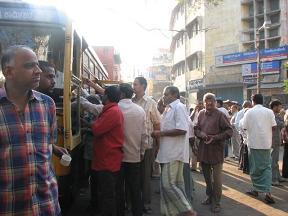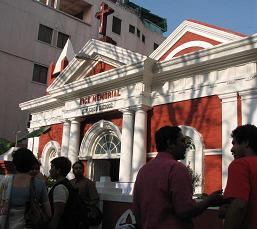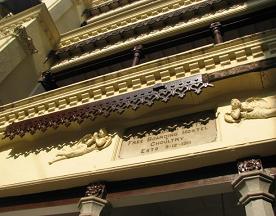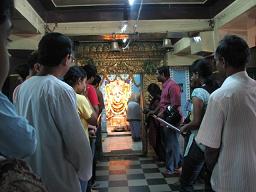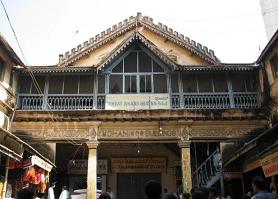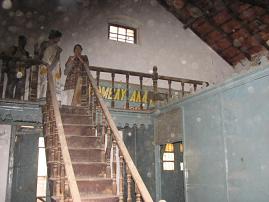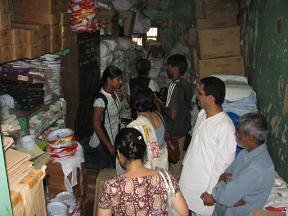Hasire Usiru
Campaign to Reclaim Bangalore's Commons
Public Action
Report: INTACH Avenue Road Walk - 8th February, 2009
Walking Down an Avenue between the Past and the Present
8th February 2009
Indian National Trust for Art and Cultural Heritage (INTACH) in collaboration with Environment Support Group (ESG) and The Avenue Road Commercial Association (TARCA) organised a Heritage Walk on Avenue Road on 8th February 2009. Twenty-five people participated in the walk. This event is part of the series of activities planned on Avenue Road to raise consciousness amongst people of Bangalore on the heritage of the road and its significance to Bangalore.
Avenue Road: A Living Heritage
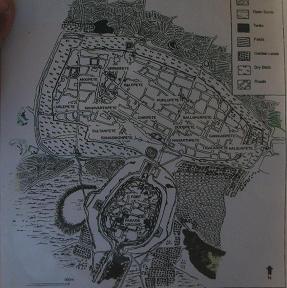
On a regular day, Avenue Road- also known as a 'mall for all classes'-represents a thriving market with thousands of sellers and buyers bargaining over a wide range of goods. The traders take pride in the diversity of the goods sold here and say that almost everything, except probably an aeroplane, can be found here.
Avenue Road holds importance for cultural reasons as well. The famous Karaga Festival, which sees the amalgamation of both the Hindu and Muslim culture is celebrated here each year. This festival in many ways is representative of what Avenue Road is- a microcosm of people who come from various religious, linguistic and geographical backgrounds of the country.
This road is also home to several heritage buildings. Some of the shops and residences on this street date back to the early 1900s, with many generations of the same family being witness to its history. Each of the religious establishments here have answered prayers of thousands of people tirelessly for years and also have many tales to tell.
Raising Roads: Erasing History
Today, the first crossroads of Bangalore, Avenue Road, is itself at the crossroads struggling to reconcile its presence in the path of the city's phenomenal growth, which wants it out of the way. As a part of a massive project, Avenue Road is being threatened by an infrastructure project that evidently has higher regard for speeding cars than timeless living structures and their people. Avenue Road is one among the 91 prime roads earmarked by the Bruhat Bangalore Mahanagara Palike (BBMP) for road-widening. The BBMP's proposal to widen this road is supposedly driven by the need to secure connectivity for those who are plying to the Bangalore International Airport from south Bangalore.
Thus the road which is about 10-15 meters wide, currently, is proposed to be widened to 24 meters. The traders have vehemently opposed the road-widening programme as it will destroy the entire shopping lines on both sides of the road, affecting thousands of families who are totally dependent on trade on this street for their livelihoods, besides depriving scores of people a place to shop at reasonable rates.
In exchange for property that is lost the BBMP promises property losers a Development Rights Certificate (DRC) under the Transfer of Development Rights (TDR) scheme. The DRC is a piece of paper that gives the property loser the right to construct 1.5 times the property lost in the remaining space, and allows construction above the existing structure in variance to existing building bye-laws. Alternatively, the property owner can trade this right to construct to anyone else in the open market, thus transferring the right of construction to the buyer.
Traders have refused to accept TDR as it cannot replace the remarkable social and commercial networks they have created on Avenue Road over many decades. Importantly, Avenue Road is flush with many traders who are not property owners, and thus will not in any manner benefit from the TDR scheme, as there is no displacement policy for those without property.
Discovering History: Capturing the Present
Hot coffee and breakfast
Swathi Reddy, co-convener of INTACH�s Bangalore chapter welcomed all the participants for the Walk, introducing Sathya Prakash Varanashi from UDBHAVA who would anchor the walk for the next few hours. After a quick brief on the current status of the road-widening project by Divya Ravindranath from ESG, Sathya took center stage, talking to the participants about how Avenue Road was a fitting answer to those who thought the idea of town planning only came to India with the British. Kempegowda�s city had roads running along the north-south and east-west axes. Within this grid were accommodated several petes or townships housing different communities and professions. Each of the petes specializes in certain goods showcasing a highly planned market space. Sathya highlighted how while the lay-outs were formal, the inner spaces were informally used by each one to his/her convenience. Another point made was, as a founded city, Bangalore, has always had a mix of cultures, beginning with when Kempegowda cleared the jungle to build his fort and invited different communities to people his new city. As a result, even today, Avenue Road is a microcosm of the country.
Sathya also spoke about how Avenue Road used to have two gateways at either end that were called the Yelahanka gate and the Anekal gate. This is almost analogous to most celebrations in Indian culture that are often given a boundary or a gate (as in the entrance built for a wedding celebration).
Here, Sathya also said that considering the lack of legislation on Heritage conservation a lot of structures are fast disappearing. This Walk holds importance not just for celebrating history but also to see how the present-living heritage can be saved.
Sathya added here that the question on how Avenue Road got its name remains. Though it is usually said to have got its name from the trees that lined it, photographs from the 1860s show all of two trees so that the origin of the name remains ambiguous.
Rice Memorial Church
After spending a couple of more minutes at the Church, the crowd moved to the Chintalapalli Venkatamuniah Setty Hostel. Meera and Divya told others that this hostel was started by the sister of the late founder of Vysya Bank, Dharmaprakash SV Srinivasa Setty. Though herself childless, she was extremely fond of children and used to bring over needy children from their village in Kolar district to their home in Bangalore. Thus began the hostel which till today supports students in need. Constructed in 1911, this building first served as their residence and there on has been home to students.
Chintalapalli Venkatamuniah Setty Hostel
Hari Ram and Dilip Shah members of TARCA who had joined the walk used the peace and quiet of the hostel to talk to the group about the proposed road-widening scheme, while the participants relished the Badam-milk provided by the Hostel. Shah and Haribhai explained that Avenue Road has never witnessed a road-accident or even congestion. Vehicular movement though slow is never stalled. They said that if road-widening would indeed take place, it would destroy lakhs of lives.
Divya also said that a few years ago the administration had come up with a similar plan to widen the inner streets ostensibly for fire security. To this, the traders had pointed out that all the structures on Avenue Road were built close to each other such that people could use the adjoining terraces to escape by jumping across structures. Hence, instead of widening, the administration could instead ensure that all electrical lines were well-maintained.
Inside the Komatipete Venkataramanaswamy Temple
Dilip Shah also shared the story of his family which migrated from Kutch during the partition of India and Pakistan. Interestingly, though Shah speaks Kutchi, he feels Bangalore is his home, because it is here that he was born, and it is here that he makes his livelihood. And this is pretty obvious when one hears Shah speak Kannada with great fluency. His family like many others on this street set up their business over 65 years ago. Today his shop has a strong network of customers not just in Bangalore but also all over Karnataka.
On request Hari Ram also shared his family's story. He said that sometime before partition his family moved from Sindh to Bangalore. His shop is a distributor for Ever-Ready Batteries. He narrated his experiences of the 50s when most people did not understand the use of batteries as they were new in the market. He recalled how the company prepared posters explaining the use of batteries. Hari Ram, like Shah, is a Sindhi speaking Bangalorean, who has seen the city grow and change.
Bombay Anand Bhavan Hotel
The blue structure of Anand Bhavan showcased the glory of yesteryears. However, the structure was in a dilapidated state reflecting the absolute neglect accorded to heritage structures in Bangalore. Out of sheer curiosity, the walkers climbed the stairs to see what lay on the top floor of the building that was clearly in shambles.
Exploring the interior of the old hotel
While passing the Doddapetta square en route to the next stop, Dilip Shah and Hari Ram pointed out yet another of Avenue Road�s markers in the long and interesting road of Bangalore�s history. This was the Doddapette square, where Tipu Sultan kept his horses in stables on the four corners. This historic square is also where Kempegwoda�s four bulls are said to have started out from, marking down the future Avenue Road.
Inside the Shri Mishrilal Indramal shop
At the end of the walk all the participants signed a petition requesting the Government to reconsider the road-widening plans for Avenue Road, keeping in mind the area�s cultural and built heritage. The participants promised to join the traders next time they have a campaign to fight the destruction of this important part of Bangalore�s heritage.
It is realized that Avenue Road is important not just for its historic buildings but also for its lively bustling market, which is living.
Report prepared by:
Divya Ravindranath and Leo F Saldanha, Environment Support Group (February 2009)
With help and support from
Meera, INTACH�s Bangalore chapter
Contact details of ESG:
Environment Support Group �, 105, East End B Main Road, Jayanagar 9th Block East, Bangalore-560069.INDIA Tel: 91-80-22441977/26531339 Voice/Fax: 91-80-26534364 Email: [email protected] or [email protected] Web: www.esgindia.org
ESG is an independent not-for-profit organisation that promotes the cause of environmental and social justice through research, documentation, advocacy, training and campaign support. We aim to support the rights of local communities and voiceless ecosystems in a responsible, progressive manner that keeps contextual complexities in mind.


